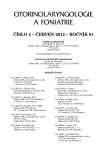Immediate Revision in Patients with Bilateral Recurrent Laryngeal Nerve Palsy after Operation of Thyroid Gland and Parathyroid Glands
Authors:
M. Zábrodský 1; P. Lukeš 1; J. Bouček 1; J. Kastner 1; M. Kuchař 1
; M. Chovanec 1,2
; J. Betka 1
Authors‘ workplace:
Univerzita Karlova v Praze, 1. LF, Klinika otorinolaryngologie a chirurgie hlavy a krku, FN v Motole, Praha, přednosta prof. MUDr. J. Betka, DrSc.
1; Univerzita Karlova v Praze, 1. LF, Anatomický ústav, Praha, přednosta prof. MUDr. K. Smetana, DrSc.
2
Published in:
Otorinolaryngol Foniatr, 61, 2012, No. 2, pp. 104-111.
Category:
Original Article
Overview
Aim of the present study was to determine whether immediate revision surgery could have any benefit for patients with iatrogenic bilateral recurrent laryngeal nerve (RLN) palsy. From January 1, 2004 to January 30, 2011, 29 consecutive patients underwent immediate revision after total thyroidectomy. Cohort comprised 29 patients, 2 males and 27 females, aged 23 to 76 years (median 52 years). Identification of the type and extent of injury of every branch was reported in the protocol, reconstruction was performed whenever possible. A complete trans section of the nerve or of one of its branches was found in 14 and 5 nerves, respectively. In three patients the nerve was completely or partially transected on both sides. Seven anatomically intact nerves were injured by loaded ligature, in one case there was a sign of thermal damage, four nerves showed sign of excessive manipulation (thinning of the nerve trunk). Primary end-to-end anastomosis was performed in seven completely transected RLN and four transected anterior branches of RLN. None of the reconstructed nerve trunks or its branches regained function, however, good muscle tone was observed. 23 out of 38 intact nerves (61%) regained function, and normal vocal-cord mobility on the both sides was restored only in four patients. In all cases with regained vocal-cord mobility the functional recovery occurred within 3 months from the primary surgery. In conclusion, immediate revision after thyroidectomy can help to precise the type of the RLN damage that is a predictor of functional recovery and one of major factors influencing future therapeutic steps.
Key words:
bilateral recurrent laryngeal nerve (RLN) palsy, immediate revision, functional recoverg, thyroid gland surgery.
Sources
1. Bhattacharyya, N., Fried, M. P.: Assessment of the morbidity and complications of total thyroidectomy. Arch. Otolaryngol. Head Neck Surg., 128, 2002, 4, 389-392.
2. Canaris, G. J., Manowitz, N. R., Mayor, G., Ridgway, E. C.: The Colorado thyroid disease prevalence study. Arch. Intern. Med., 160, 2000, 4, s. 526-534.
3. Dralle, H., Sekulla, C., Lorenz, K., Brauckhoff, M., Machens, A.: Intraoperative monitoring of the recurrent laryngeal nerve in thyroid surgery. World J. Surg., 32, 2008, 7, s. 1358-1366.
4. Grossmann, M.: Experimentelle Beiträge zur Lehre von der. ‘’Posticuslähmung’’. Arch. Laryngol. Rhin., 1897, 6, s. 282.
5. Hermann, M., Alk, G., Roka, R., Glaser, K., Freissmuth, M.: Laryngeal recurrent nerve injury in surgery for benign thyroid diseases: effect of nerve dissection and impact of individual surgeon in more than 27,000 nerves at risk. Ann. Surg., 235, 2002, 2, s. 261-268.
6. Hermann, M., Hellebart, C., Freissmuth, M.: Neuromonitoring in thyroid surgery: prospective evaluation of intraoperative electrophysiological responses for the prediction of recurrent laryngeal nerve injury. Ann. Surg., 240, 2004, 1 s. 9-17.
7. Higgins, T. S., Gupta, R., Ketcham, A. S., Sataloff, R. T., Wadsworth, J. T., Sinacori, J. T.: Recurrent laryngeal nerve monitoring versus identification alone on post-thyroidectomy true vocal fold palsy: a meta-analysis. Laryngoscope, 121, 5, s. 1009-1017.
8. Chan, W. F., Lang, B. H., Lo, C. Y.: The role of intraoperative neuromonitoring of recurrent laryngeal nerve during thyroidectomy: a comparative study on 1000 nerves at risk. Surgery, 140, 2006, 6, s. 866-872; discussion 872-873.
9. Chan, W. F., Lo, C. Y.:. Pitfalls of intraoperative neuromonitoring for predicting postoperative recurrent laryngeal nerve function during thyroidectomy. World J. Surg., 30, 2006, 5, s. 806-812.
10. Kruse, E., Olthoff A, Schiel R.: Functional anatomy of the recurrent and superior laryngeal nerve. Langenbecks Arch. Surg., 391, 2006, 1, s. 4-8.
11. Lo, C. Y., Lang, B. H., Chan, W. F., Kung, A. W., Lam, K. S.: A prospective evaluation of preoperative localization by technetium-99m sestamibi scintigraphy and ultrasonography in primary hyperparathyroidism. Am. J. Surg., 193, 2007, 2, s. 155-159.
12. Procacciante, F., Picozzi, P., Pacifici, M. et al.: Palpatory method used to identify the recurrent laryngeal nerve during thyroidectomy. World J. Surg., 24, 2000, 5, s. 571-573.
13. Randolph, G. W., Dralle, H., Abdullah, H. et al.: Electrophysiologic recurrent laryngeal nerve monitoring during thyroid and parathyroid surgery: international standards guideline statement. Laryngoscope, 121 Suppl 1, s. 1-16.
14. Shaw, H. S., Deliyski, D. D.: Mucosal wave: a normophonic study across visualization techniques. J. Voice, 22, 2008, 1, s. 23-33.
15. Steurer, M., Passler, C., Denk, D. M., Schneider, B., Niederle, B., Bigenzahn, W.: Advantages of recurrent laryngeal nerve identification in thyroidectomy and parathyroidectomy and the importance of preoperative and postoperative laryngoscopic examination in more than 1000 nerves at risk. Laryngoscope, 112, 2002, 1, s. 124-133.
16. Svec, J. G., Sram, F., Schutte, H. K.: Videokymography in voice disorders: what to look for? Ann. Otol Rhinol. Laryngol., 116, 2007, 3, s. 172-180.
17. Thermann, M., Feltkamp, M., Elies, W., Windhorst, T.: Recurrent laryngeal nerve paralysis after thyroid gland operations. Etiology and Consequences. Chirurg, 69, 1998, 9, s. 951-956.
18. Wang, C.: The use of the inferior cornu of the thyroid cartilage in identifying the recurrent laryngeal nerve. Surg. Gynecol. Obstet., 140, 1975, 1, s. 91-94.
Labels
Audiology Paediatric ENT ENT (Otorhinolaryngology)Article was published in
Otorhinolaryngology and Phoniatrics

2012 Issue 2
Most read in this issue
- Erythema Multiforme in ENT
- Extranodal NK/T Cell Lymphoma, Nasal Type - an Unusual Cause of Unilateral Nasal Obstruction
- Present View of Adenotomy a Tonsillectomy in the Czech Republic (a questionnaire study)
- Immediate Revision in Patients with Bilateral Recurrent Laryngeal Nerve Palsy after Operation of Thyroid Gland and Parathyroid Glands
